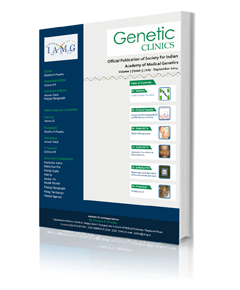| E-mail ID : info@iamg.in |
| E-mail ID : info@iamg.in |
Online Submission |
| Click Here For Online Submission |
| Instructions for authors |
Genetic Clinics |
| Editorial board |
Get Our Newsletter |
| Subscribe |
Send Your Feedback |
| Feedback Form |
About Us |
| IAMG |

Volume 12 | Issue 2 | April to June 2019 |
| Download Complete Issue |
| View Complete Issue |
GeNeDit |
|||
| April to June 2019| Vol 12 | Issue 2 | Page No 1-2 | |||
| Marching towards Prenatal Treatments: Training in Ethics and Communications the Need of the Hour | |||
| Diagnosis of genetic disorders has taken a big leap in the 21st century. The ease with which the whole exome and whole genome can be sequenced suggests that this can be the first step of medical evaluation for any individual, may be immediately after birth or prenatally. Dr. Shubha Phadke |
|||
| HTML Full Text | Download PDF |
HearToHearTalk |
|||||
| April to June 2019| Vol 12 | Issue 2 | Page No 2-3 | |||||
| `JAYA' of Mind over Bones! | |||||
| We think bones are the strongest part of body and cannot be easily broken. I doubted this once again when Jaya and Vijaya (names changed) came to meet me. I had seen them for the first time more than a decade ago on television shows singing songs and talking about their 'incurable' Dr. Shubha Phadke |
|||||
| HTML Full Text | Download PDF |
Clinical Vignette |
||||||
| April to June 2019| Vol 12 | Issue 2 | Page No 4-5 | ||||||
| Rare Type of Epidermolysis Bullosa Associated with the ITGB4 Gene: Journey with the Patient's Family | ||||||
| Next generation sequencing (NGS) is a boon for patients with rare monogenic disorders and their physicians. Epidermolysis bullosa (EB) is a genetic disorder with genetic and phenotypic variability. This report discusses the case of a neonate with a rare type of EB caused by biallelic pathogenic variants in the ITGB4 gene and the long term
Shubha R Phadke, Dhanya Lakshmi Narayanan |
||||||
| Abstract | HTML Full Text | Download PDF |
GeNeViSTA |
||||||
| April to June 2019| Vol 12 | Issue 2 | Page No 6-10 | ||||||
| Carrier Screening and Prenatal Counseling for Inborn Errors of Metabolism: Challenges in the Indian Scenario | ||||||
| Carrier screening for inborn errors of metabolism (IEMs) in the Indian population is challenging because of factors such as consanguinity, inbreeding and inadequate work up done for the index patients. Proper carrier screening is the key to offer accurate prenatal counseling and diagnosis for IEMs.
Chaitanya A Datar |
||||||
| Abstract | HTML Full Text | Download PDF |
GeNeViSTA |
||||||
| April to June 2019| Vol 12 | Issue 2 | Page No 11-18 | ||||||
| Epidermolysis Bullosa: An Update | ||||||
| Epidermolysis bullosa (EB) is caused by mutation in various components of the basement membrane zone and is characterized by increased fragility of skin and mucous membrane. There are four major types based on the level of split at the basement membrane zone – involvement of basal layer
Neetu Bhari1 , Neerja Gupta2 |
||||||
| Abstract | HTML Full Text | Download PDF |
GeNeXprESS |
||||||
| April to June 2019| Vol 12 | Issue 2 | Page No 19-20 | ||||||
| Nip it in the Bud: Prenatal Detection and In-utero Correction for Monogenic Disorders | ||||||
| Fetal structural anomalies are etiologically heterogeneous. The etiology can vary from chromosomal aneuploidies and copy number variations (CNVs) to single gene defects and multifactorial causes. Priya Ranganath, Prajnya Ranganath |
||||||
| Abstract | HTML Full Text | Download PDF |
PhotoQuiz |
||
| April to June 2019| Vol 12 | Issue 2 | Page No 21 | The proband has biallelic disease-causing variants in the GM2A and in NIPAL4 genes, causing GM2 gangliosidosis AB variant (MIM #272750) and autosomal recessive congenital ichthyosis 6 (MIM #612281) respectively. The parents are heterozygous carriers for both the variants. Dr Dhanya Lakshmi N |
|
| View PhotoQuiz | Click here to send your answer |
GeNeEvent |
||
| Fifth National Conference of the Indian Society of Inborn Errors of Metabolism |
||
| Read More | Download PDF |
Announcements |
|||
| 7th International Conference on Rare and Undiagnosed Diseases: Addressing Patient Needs for Rare Disorders in India | |||
| Download PDF |